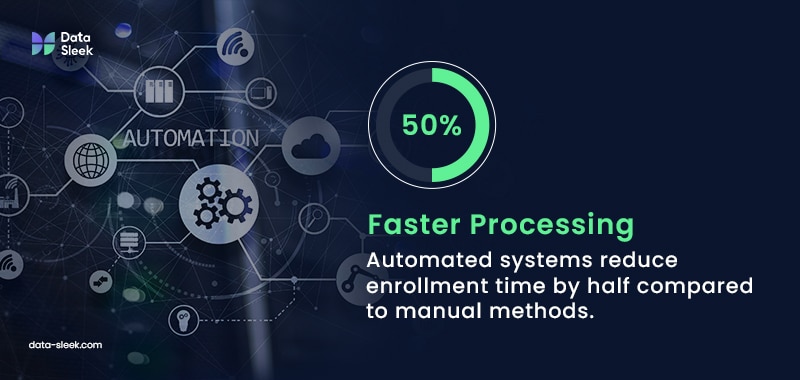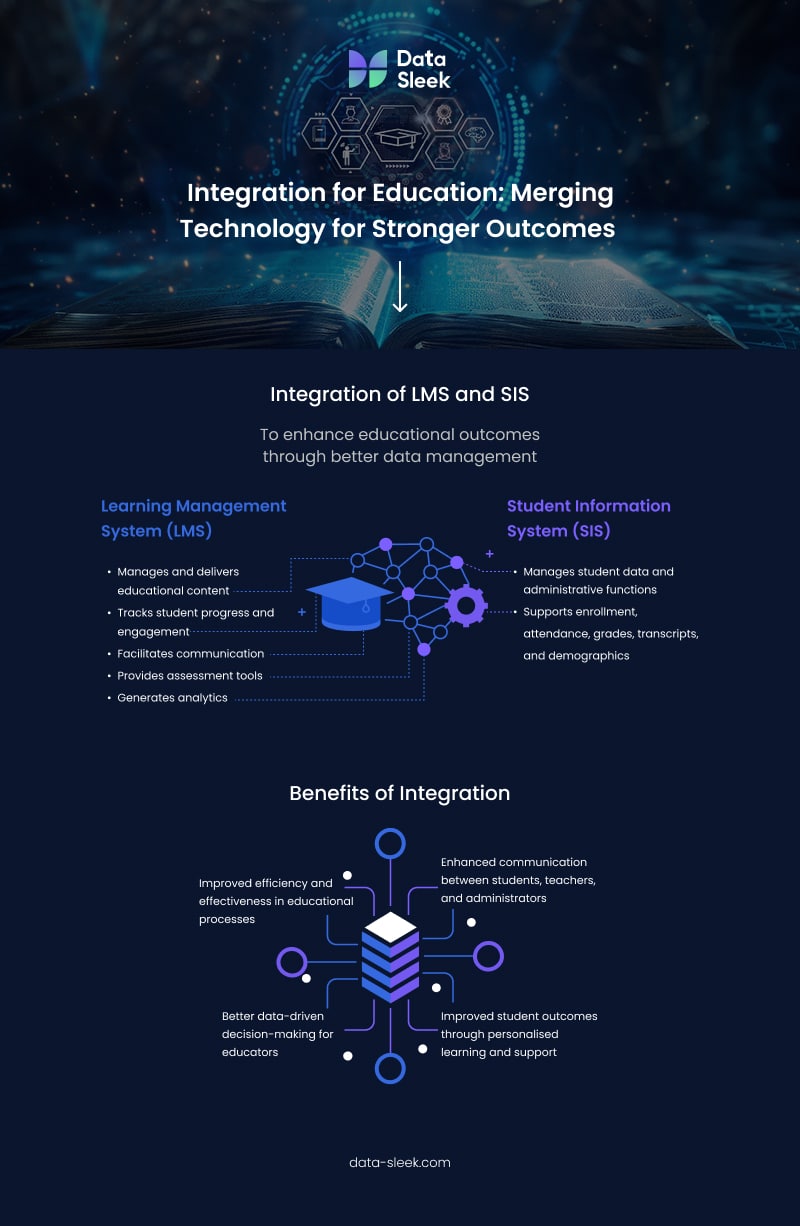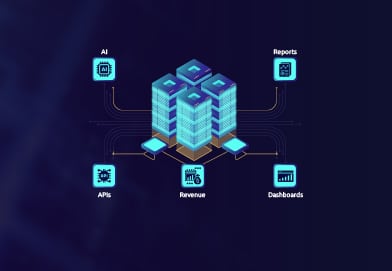
The education sector is one of the last of the major industries to embrace the power of data management. However, leaders in the industry are catching on to how data is revolutionizing the student experience and leading to better outcomes. From enhancing personalized learning experiences to streamlining administrative processes, data management in education is no longer a luxury, but a necessity.
From Chalkboards to Cloud Servers, How Data is Reshaping Education
Say you’re attending your high school reunion (shudder) or a neighborhood block party, and you’re in the throes of introductions and small talk when you hear a new acquaintance say that he works in “data management”: what comes to mind? Perhaps a bookish tech whiz holed up in a windowless office, elbow-deep in computer programming manuals, or a pedantic analyst giving obscure industry counsel to corporate moguls.
Truth be told, neither of these depictions represents the reality, but there’s a high likelihood that “data management” does not conjure images of students, chalkboards, and the strident alarm of the morning school bell. But in recent years, educators, legislators, administrators, and information technology specialists have been clamoring for the utility of data management within the education industry to ensure personal security and safety of personal information, tailor curriculums, and organize data to ensure that resources, attention, and efforts are allocated properly.

The intrepid pioneering days of the one-room clapboard schoolhouse and lunch pails now live only in books and old movies. Worldwide, education is now a mammoth industry; to date, education is in the top 10 largest industries in the United States and ascending the ranks fast. The education industry was estimated to be worth a staggering $1.4 trillion in 2021. With a growth rate of more than 4% annually, it’s predicted to be worth in the ballpark of $3 trillion by 2030. This year, nearly 50 million students entered the doors of public schools all over the United States, with another 5 million or so in private schools. The size, scope, and projected growth of the education system means that managing data can help ameliorate the innumerable challenges that the industry now faces.
The world we live in is undeniably fueled by data, and educational institutions are no exception. From kindergarten classrooms all the way to higher education, robust data management has the potential to transform the landscape for the better. Effective data management has the real potential to improve learning outcomes, equitably distribute resources, and set clear, actionable steps towards achieving clear, achievable goals.
The Role of Data Management in Enhancing Educational Quality
Within the education system, data management is much more than simply organizing and storing data into a massive vault. It helps to leverage collected data to improve every sphere of the education system. It can help identify which school districts may need extra resources by tracking distribution, eliminate built-in inequities in standardized testing and university admissions, and even tailor curriculums to ensure the success of each student.
By efficiently collecting, storing, and analyzing student data, institutions gain valuable feedback about student performance and learning patterns. This information allows educators to clearly see where they can improve their lesson plans and approach. This data-driven approach empowers educators to make informed decisions, personalize learning experiences, and tailor their instructional strategies to meet the diverse needs of their students.

Accessible Student Information Creates More Effective Teachers
The potential for data management, especially with modern AI integration, extends beyond enhancing academic performance. Well-managed data streamlines administrative tasks, such as student enrollment, attendance tracking, and scheduling, freeing up teachers’ time to focus on what they do best – shaping the young people who will become the leaders we need. Efficient data management processes also enhance communication and collaboration among stakeholders – teachers, administrators, parents, and students – by providing them with timely access to relevant information.
Dedicated teachers spend years honing their craft and care deeply about their students. Efficient data management frees them up from the administrative tasks that keep them from being as effective as they could otherwise be.
Optimizing the Student Enrollment Process
Strong data management systems simplify the student enrollment process by allowing administrators to track applications, manage student records, and monitor enrollment trends in real-time. The amount of time spent on manually inputting enrollment data on each student is a tremendous drain on teachers.

There’s a solution. Automated data management systems, which reduce enrollment processing time by 50% compared to schools that still use manual entry and paper-based systems. By centralizing enrollment data, administrators can also forecast class sizes, allocate resources more efficiently, and ensure the right teacher-to-student ratios are maintained.
Extracting Deep Insights From Attendance Tracking
Education data management platforms are built with automated attendance systems integrated directly into the interface, so tracking student attendance becomes seamless. Faculty can see information about student absences and tardiness immediately, allowing them to intervene quickly when patterns of absenteeism arise.

The significance of identifying patterns in truancy cannot be overstated. Students who present with chronic absenteeism, defined as missing more than 10% of school days, are 7 times more likely to drop out than their peers. Identifying patterns in student behavior and the factors surrounding them generates valuable insights to educational institutions. Taking corrective action to understand why absenteeism is happening can provide greater insight into changes in student needs, education quality, and other extenuating factors.
The long term academic and social effects of chronic truancy reverberate for decades, so having access to this data allows for quick remediation. Crucially, it also helps keep parents in the loop and can prevent the known consequences that often accompany absenteeism. In the U.S., approximately 59% of incarcerated individuals reported a history of truancy as children. The unfortunate reality makes sense when we look at the numbers: students with frequent absences from school are more likely to drop out, and dropouts are 3.5 times more likely to be arrested than their peers who graduate from high school.
Safeguarding Students with Data
The implications of chronic truancy don’t just inform a students’ later life trajectory. These patterns are often evidence of neglect, malnutrition, and other forms of abuse in the home, particularly for grade-school children. Roughly 25% of primary-school aged children in the United States who miss school too often are victims of at least one type of maltreatment in the home.
The attendance tracking within schools that use digital attendance systems are 20% more accurate and efficient than those that use manual systems. Because we know that the empirical consequences for chronic absenteeism are so dire, the utility of integrating data management into tracking attendance patterns seems self-evident. Evidence-based data management strategies do more than help educators prepare the best lessons and give personalized attention; it can also help school staff recognize when a child or adolescent may need help.
Efficiency in Parent Scheduling and Communication
Caregivers and administrators alike often know the frustration of trying to communicate about a student and schedule meetings. Data management systems can save countless headaches by allowing for simple scheduling, avoiding clashes and ensuring that parents can easily select slots based on their availability. Many data management systems send automatic reminders, which is especially useful since missed meetings and communication gaps can have a negative impact on student performance outcomes.
EdTech Magazine reports that 65% of schools using digital management platforms saw marked improvement in parent-teacher communication and easier scheduling . The free flow of information strengthens the home-school connection, which is key for long-term student success.
Resource Allocation and Financial Management
Even the politically apathetic have caught wind of the dissension in school board meetings during these last few years, and the complaints from parents and administrators alike are far-reaching. But a recurring complaint from both sides is whether resources are used effectively and how best to budget tax dollars. The end of 2024 marks the end of federal stimulus funding set aside for K-12 schools as remediation for post-COVID budgetary constraints. Funding for administration and operating costs is becoming increasingly tighter, making it the perfect time for more schools to introduce data management systems to ease the strain of budgeting.
On average, schools save up to 15% in operational costs by streamlining financial processes, like procurement and payroll, using data-driven tools. Administrators can see where funds are being spent and make decisions based on real-time data. The data allows for the most expedient decision-making; the data feedback is immediate, so when it shows a drop or increase in student engagement in certain areas, such as a particular extracurricular activity or a tutoring service, funds can be reallocated and channeled, whether that means investing in new teaching tools, hiring more staff, or upgrading facilities. This reduces waste and increases efficiency across the board.

Ensuring Accuracy and Consistency of Student Information
Without consistently accurate student information, even the most passionate educators’ efforts are nearly impossible to implement. Education data management ensures that available data related to student information is verified, up-to-date, and maintained with regular frequency. Personal details, academic records, attendance, grades, assessments, and extracurricular activities are crucial for all sectors of administrative and academic processes.
Just like a data management system in a for-profit corporation, educational data management is of little use if the collected information isn’t high-quality data. This requires a multifaceted approach that includes implementing verified data entry procedures, validating data at the point of entry, and conducting regular data audits to identify and rectify any data quality inconsistencies.
By establishing clear guidelines and providing adequate training on data entry procedures, institutions can minimize errors and ensure that student data collection is reliable and trustworthy. Furthermore, integrating data management systems with other school applications, such as learning management systems (LMS), can help avoid data duplication and improve data consistency across different platforms.
Streamlining Administrative Processes for Efficiency
Another significant benefit of robust data management in education lies in its ability to streamline administrative processes, thereby enhancing overall efficiency. By automating tasks like attendance tracking, grade reporting, and transcript generation, schools can significantly reduce the administrative burden on staff. This, in turn, frees up valuable time for educators to focus on their primary role – teaching and supporting student learning.
Workflows can be optimized to eliminate manual data entry and reduce the chances of errors, ensuring smoother and faster completion of administrative tasks. Real-time data availability allows administrators to make quick and informed decisions regarding resource allocation, scheduling, and other critical operational aspects. Furthermore, centralized data management systems facilitate better communication and coordination among different departments within the institution, creating a more streamlined and efficient workflow.
Key Components of Effective Data Management Systems in Schools
Effective data management in education the implementation of comprehensive solutions that cater to the unique needs of the school community. These systems should prioritize data security and privacy, while also providing user-friendly interfaces and tools for effective data analysis and reporting.
Integration with existing school systems, such as Learning Management Systems (LMS) and administrative platforms, is crucial to avoid data silos and enable seamless data flow across the institution. Additionally, providing adequate training and support to staff members on using the data management system effectively is essential for maximizing its impact and ensuring its long-term success.
Secure Storage and Easy Retrieval of Data
Using Data to Keep Track: Safety In Numbers
Increasing reports of violence in schools have caused concern for the safety of educational facilities, students, and faculty. Data management systems that require multi-tier user credentials act as a protective layer to shield stakeholders from harm. Security through data systems monitor multiple facets of the educational sphere and cover everything from maintaining records to using AI to detect suspicious activity.
All the data that’s collected on who comes into the building is critical for parents who want reassurance about their children’s whereabouts. Aggregated security data can be used to inform elected officials. I also provides evidence for greater funding and more robust security measures and safety strategies in high-risk areas. For school systems around the country face mounting budgetary pressures, this can be a game-changer.

Ramping Up Data Management to Mitigate Security Breaches
Data is undeniably amazing. Our lives revolve around it: collecting it, analyzing it, studying it to make smart decisions for our lives. As much as the education industry relies on data to enrich the lives of millions of students, it is not exempt from becoming a target of data breaches. Hackers are getting savvier and more conniving, and data breaches are becoming increasingly common, so securing sensitive student information is paramount.
Roughly 60% of data breaches are due to internal factors like human error or improper access controls, so regular audits to ensure valid user credentials is imperative. Because they are concentrated repositories of personal information, educational institutions may be at higher risk of cyberattacks than other organizations.
Consider the facts:
- In 2021, over 1,300 schools in the U.S. were affected by ransomware attacks, putting millions of student records at risk.
- Between 2005 and 2020, U.S. school districts experienced 1,851 data breaches impacting around 28 million records. Many breaches occur due to inadequate data management or failure to patch security holes.
- As of 2021, the cost of a data breach in the education sector is higher than elsewhere, averaging $3.79 million per breach.
- Schools that regularly monitor and audit their data systems have 25% fewer security incidents than those that don’t.
On top of conducting regular data audits to reduce the risk of these costly incidents, it makes sense that data management systems in schools prioritize their secure storage and retrieval of data. Strong encryption protocols and access control mechanisms are the best protection against unauthorized access, data loss, and cyberattacks.
Here are the best practices to protect educational data:
- Storing data on secure servers
- Conducting regular backups and having disaster recovery plans in place
- Allow for easy and timely access to authorized personnel, such as teachers and administrators, who require the information to perform their duties effectively.
This balance between data security and accessibility is vital for ensuring the smooth functioning of the institution while maintaining the privacy and confidentiality of student data.

Integration for Education: Merging Technology for Stronger Outcomes
We all learned in school that working together to solve problems can lead to better outcomes. Technology in data management is no different. A real-life application is the integration of a learning management system and a student information system.
A learning management system (LMS) is a software platform that helps educators manage and deliver educational content. It allows teachers to create, distribute, and track learning materials, assignments, quizzes, and discussions, while also providing a space for students to engage with course content online. LMS platforms were widely adopted during the COVID-19 pandemic, and were proven so efficient that they are still used in e-learning and blended learning environments.
In and out of the classroom, a LMS is useful tool for:
- Content Delivery: Allows teachers to upload lessons, videos, assignments, and quizzes.
- Tracking Progress: Tracks student engagement, completion of assignments, and grades.
- Communication: Enables interaction between students and teachers via discussion forums, announcements, and direct messaging.
- Assessments: Provides tools for creating and grading quizzes, exams, and assignments.
- Analytics: Generates reports on student performance and engagement metrics.
As both a supplement and a complement to a learning management system is a student information system (SIS). A SIS is a centralized platform that manages student-related data and administrative functions such as enrollment, attendance, grades, transcripts, and demographics. SIS systems are designed for administrators, teachers, as well as students to manage logistical aspects of schooling.
How does data management help support a centralized learning platform?
When data management systems like an LMS and SIS work together to support a centralized learning platform, schools benefit from enhanced data accuracy, data quality, streamlined administrative processes, and improved communication between all parties involved. This integration ultimately helps teachers focus more on teaching and less on administrative work, while simultaneously providing a more personalized and efficient learning experience for students.
How LMS and SIS Create A Digital Dialogue
Let’s say a student wants to enroll in a biology course. Here’s how these two integrated systems communicate to create a seamless digital dialogue:
- The student enters his identification data into the SIS to enroll in the class, which automatically registers him for the biology course in the LMS.
- The professor uploads course materials and assigns a project through the LMS, and the student completes and submits it.
- Once the project is graded in the LMS, the grade is automatically synced to the SIS, where it becomes part of the student’s official transcript.
- If the student is absent for a week, the attendance data in the SIS can trigger alerts in the LMS for missed assignments, prompting the teacher to reach out for follow-up.
This seamless flow of information between systems is the result of effective data integration—a process that ensures all your digital platforms work in harmony. With the right data integration solutions, schools can unify their systems, eliminate data silos, and make operations more efficient.
Impact of Data Management on Student Learning Outcomes
Ultimately, the objective of implementing strong, effective data management systems in education is the same for students, elected officials, parents, and teachers: to create meaningful, positive impact on learning. Data analytics give educators the power to gain a deeper, more nuanced understanding of each student’s individualized needs by identifying learning gaps and creating targeted interventions. Since each student learns differently, personalized learning systems created by data management can improve student outcomes by a whopping 15%. By analyzing student data on performance and engagement, teachers can customize lessons to address individual strengths and weaknesses.
Using data systems to create precision demarcations within composite student groups can help students get the lesson plans they need. A study from RAND showed that schools that used data systems for differentiation saw +11 percentile points in student test scores. The equity and credibility of standardized test scores notwithstanding, they are often used as markers for resource allocation for school districts, so higher scores can mean better resources for students.
Personalized Learning Plans Based on Data Analysis
When students feel heard, they’re far more likely to relate to the academic material and their surroundings. Schools that use data-driven personalized learning report a 30% increase in student engagement. Tracking student progress in real-time helps teachers see which students need more support and which are ready for more challenging material.
Individualized curriculums tailored to students who need extra support were once only a fantasy of idealistic teachers. Now, with data-driven Individualized Education Plans (IEPs), these customized teaching schedules are a reality. According to a study from the National Center for Learning Disabilities (NCLD), students with special needs showed a 20% improvement in academic performance when teachers used data-driven Individualized Education Plans to tailor instruction.
Both public and private schools have to comply with compliance laws, including criteria for IEPs. Schools that use data management systems reported a 25% improvement in compliance with IEPs and other legal requirements for special education students. Data systems help teachers track progress on individualized goals and make sure that they are following the prescribed accommodations and modifications.
Challenges in Implementing Data Management Solutions
While the benefits are undeniable, implementing data management solutions in schools is not without challenges. The passion and dedication required to be an effective educator can mean resistance to change. This resistance, combined with concerns about privacy and the need for adequate infrastructure and training are all hurdles that can be addressed and overcome.
Like any big change, navigating it successfully requires vision, patience, and finesse. Addressing privacy concerns with honesty and transparency and providing ongoing support and training to staff. Overcoming these obstacles is essential to fully realizing the transformative power of data management in education.
Addressing Privacy and Security Concerns
Anytime we’re dealing with sensitive data, and lots of it, there are some significant security risks, so no wonder that one of the primary concerns surrounding the implementation of data management systems in education is rightfully data privacy and security. This concern isn’t without merit: according to a 2020 study by the K-12 Cybersecurity Resource Center, over 1,000 data breaches occurred in K-12 schools between 2016 and 2020. But while the fear of vulnerability is understandable, there are plenty of steps educational institutions can take to allay those fears.
What Educational Institutions Can Do:
Data encryption measures to protect data from unauthorized access and cyberattacks. Strict access control protocols, where only authorized personnel have permission to view and manage student data, can keep bad actors out of sensitive data and alert authorities at the first sign of a data breach.
Adhering to relevant data privacy regulations, such as the Family Educational Rights and Privacy Act (FERPA) in the United States, is non-negotiable. Lastly, making sure there is full transparency with parents and students about how their data is collected, used, and protected is important for establishing trust and ensuring legal compliance.

Overcoming Resistance to Change Among Staff
Teachers are known for having an unmatched dedication to their students and their vocations. While this is a tremendous boon to those whose lives they shape, it can often mean that educators are resistant to adopting new data management technologies. This suspicion is often rooted in a scarcity of adequate familiarity with the data systems. A report by EdTech Magazine revealed that 47% of teachers cite lack of training and fear of change as barriers to implementing new data systems.
What Educational Institutions Can Do:
Offering comprehensive, ongoing training and professional development for teachers and staff is a simple yet effective measure that districts can take. Training tailored to different skill levels and roles, as well as ongoing support such as help desks, can help ease the transition. Demonstrating how data systems can save time and improve outcomes can also encourage adoption. Empirical longitudinal studies proving the effectiveness of data-driven individualized education plans are particularly helpful convincing recalcitrant faculty members.
Successfully managing this change requires clear communication, comprehensive and ongoing training, and resource support. Communicating the benefits of the new system to staff and emphasizing how it can streamline their work, reduce administrative burden, and ultimately improve student outcomes. Providing adequate training opportunities for varying levels of technical expertise will give staff members the confidence to embrace the new system with enthusiasm.
Although the education industry is growing at a brisk clip, those who work in this industry are cut from a different cloth than the average entrepreneur or for-profit business leader. Educators and school administrators dedicate their lives to changing the futures of young people, so they are likely to be amenable to persuasive, reasonable changes that benefit young lives.

Looking to Graduate Your Data Management System? We Can Help
Effective data management is not just a trend but a necessity in the education sector. By ensuring accuracy, streamlining processes, and personalizing learning, schools can significantly enhance educational quality and student outcomes. Integrated systems that securely store and analyze data play a pivotal role in shaping the future of education. However, challenges like privacy concerns and staff resistance must be addressed for successful implementation. Embracing data management solutions is key to fostering a more efficient and student-centered learning environment.
If you’re ready to transform your school’s approach to data, take the first steps today and set up a free consultation with a data management consultant at Data-Sleek to get started towards establishing a robust data management system.







